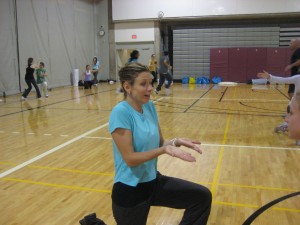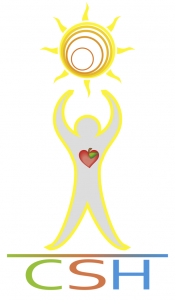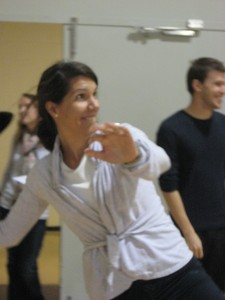Inside the Montpetit Gymnasium on a chilly day, our comprehensive school health cohort students were warming up through participation in a cooperative games active seminar led by Bob Thomas, the Health and Physical Education (HPE) consultant for the Ottawa Catholic School Board. He is well-known in HPE educational communities across Ontario as well as Canada and the students were very lucky to share some time with him. They learned about some cooperative games they might use with their students during their practicum experiences and beyond.
We were zipping across the gym with clothespins in hand, trying to ‘pin’ one another in relay-styled cooperative games; we played the part of flushing toilets in a tag game; and we used cleaning sponges and cones as manipulatives! Certainly, one lesson learned was that even without large budgets and the newest, flashiest equipment, teachers can deliver creative lessons that speak to the importance of teamwork and cooperation.
Landmarking
Younger students often need to be taught to recognize personal space and general/shared spaces in the gymnasium. We can help them by playing games that incorporate space awareness as an integral component. For example, in Cone Turn-Over, students are asked to take a cone and find personal space in the gym where they won’t be touched by anyone else. Once in their own spaces, half of the students are asked to place their cones sideways on the ground, while the other half are instructed to place their cones upright on the ground. Then, the students move all around the gym in general space (taking care not to bump into anyone else) using various locomotive skills (run, jump, skip, hop, gallop, etc.). The students who had sideways cones attempt to place all the upright cones on their sides. The students who had upright cones attempt to place all the sideways cones right side up. It’s a never-ending game of sideways and uprights, but the kids get the opportunity to raise their heart rates and learn to cooperate with their teammates to see which side can get the most cones tipped in their favour…
Physical and Health Literacy
This cornerstone of the revised Ontario HPE curriculum describes the physically literate individual as one who can move with competence in a variety of physical activities that benefit the development of the whole person (Mandigo et al., 2009). For more information about integrating the concepts associated with physical literacy into your HPE lessons, please see the Ontario Curriculum, Grades 1-8: Health and Physical Education, Interim Edition, 2010 (revised) at http://www.edu.gov.on.ca/eng/curriculum/elementary/healthcurr18.pdf.
Positivity

Equipment
Sponges: $1.25 for 6;
Cones: $1.25 each;
Clothespins: $1.25 for 50;
Promoting cooperative learning: priceless!
The point was certainly made that your equipment options are limitless if your imagination is boundless (even if your wallet is penniless!). We all understand the realities of budget crunches on physical education equipment purchases. If you do need to spend out-of-pocket, make it cheap: hit up the local dollar store and purchase some cheap toys (or cleaning products!) and use these materials as game equipment. Not only will you be saving cash, but think of what your imaginative approach could inspire in a child…
Don’t be Afraid to Make it Cross-Curricular
Using a cross-curricular approach can help enhance students’ understanding of various subject matter. We learned a neat game that asked students to practice their literacy skills while engaging in physical activity. Writing one letter of the alphabet on each tennis ball in a set of about fifty (but use as many as required to satisfy the size of your class), he scattered across the gym. Having collected as many balls as possible, students were placed into groups and used the tennis balls to create word chains in a modified game of Scrabble. For further modification, try writing numbers and mathematical symbols and asking students to perform as many equations with solutions as possible given their grouping of numbers and symbols.

